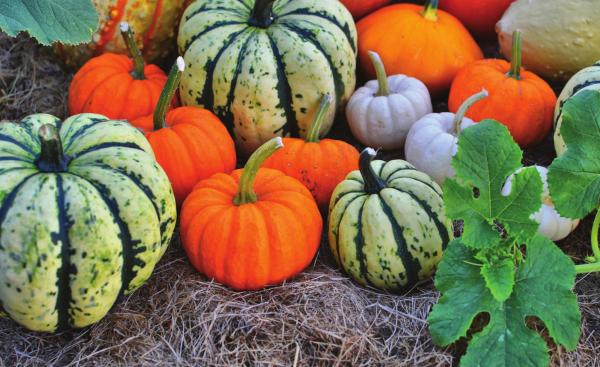The winter garden
Growing pumpkins stands as an enduring symbol of fall, whether they end up as smiling jack-o’-lanterns or stacked near cornstalks for a lovely autumn scene. But it is just the beginning of summer should I be thinking about pumpkins now? Yes, you should because now is the perfect time to get pumpkin plants into the ground!
In the garden, pumpkins crave lots of moisture, compost-enriched soil, and plenty of sun. Meet those requirements, and these sprawling vines will bear a bumper crop of this vegetable that boasts more than simply good looks. It is also full of nutrition, dishing up vitamin C, beta-carotene, fiber, and potassium. One half cup of cooked pumpkin provides a day’s supply of vitamin A.
Pumpkins come in different sizes and have different varieties of each size. The larger the pumpkin, the more days it takes for it to reach full growth. Also, the larger the pumpkins the larger the vines. Below, I’ll share the size of pumpkins, the most common uses, and some popular varieties for each size:
1. Small Pumpkins - Small pumpkins range anywhere from two to five pounds. They’re often used for baking. Some of the most popular varieties of this size are:
• Baby Bear: 105 days to maturity
• Small Sugar: 100 days to maturity
• Baby Pam: 100 days to maturity
2. Medium Pumpkins - The medium sized pumpkins weigh anywhere from eight to fifteen pounds. They can be used for baking, decorating, or making jack o’lanterns. The most popular varieties of this size are:
• Autumn Gold: 100 days to maturity
• Jack O’Lantern: 75-115 days to maturity
3. Large Pumpkins - Large pumpkins range from 15-20 pounds. They’re known for their large vines and are great for use around Halloween. The most popular varieties of this size are:
• Big Tom: 120 days to maturity
• Cinderella: 84-100 days to maturity
• Jumpin’ Jack: 110- 120 days to maturity
• Happy Jack: 105- 110 days to maturity
4. Jumbo Pumpkins - Jumbo sized pumpkins are known to reach anywhere from 50-100 pounds. These varieties, if cared for properly, could reach even greater sizes and are great for competing, decorations, and could still be used to cook with as they’re known for maintaining good flavor as well. However, the larger the pumpkin, the larger and more invasive the vines can be. Keep this in mind, when growing these larger varieties:
• Mammoth Gold: 105-120 days to maturity
• Prize Winner: 120 days to maturity
Plant pumpkins in early summer near the edge of your garden. Pumpkins need the sun but our hottest summer heat can stress them so if you can plant them so that they get late afternoon shade that is best. Space pumpkin plants 2 to 5 feet apart (depending on the variety). Grow each pumpkin on a 3-foot wide mound of warm, fertile soil that has a pH of 6.0 to 6.8.
Improve your native soil by mixing in several inches of aged compost or other rich organic matter.
Pumpkins require a lot of water, so it’s best to use a soaker hose or drip irrigation. Avoid wetting the leaves. Give your pumpkins plenty of nourishment with a continuous-release plant food, too.
As pumpkins start to form, elevate them off the soil to prevent rotting.
Harvest your pumpkins once they reach their ideal color. The skin should be firm, and stems will have started to wither.
You might have fun growing pumpkins in a bucket! This method is excellent for people who are short on gardening space but would love to grow pumpkins. It’s easy too. You begin with a 10-gallon bucket. Turn the bucket over and drill holes in the bottom of it. This is to allow any water to drain through the bucket to keep the soil from becoming too soggy.
Again, you want nutritious soil which is also welldrained. When the holes have been made, place four or more rocks in the bucket which are the size of your fist. This helps the soil to drain better as well.
From here, add rich soil to the bucket filling it to the top. When the soil is in place, you can transplant your pumpkin plants or sow seeds in the dirt. One 10-gallon bucket should hold two pumpkin transplants. If sowing seeds in the bucket, plant 4 seeds one inch deep in the soil.
When the plants reach three inches tall, you’ll cut it back to the two strongest of the plants The vines will run over the bucket and sprawl across the lawn.
This method is good if you have poor soil conditions, and it also works if you’re new to gardening. You can see how the vines sprawl, and if you need to move the plant to a new place when the vines take off, you can. This is also a fun project to do with kids.
Like its cousin the cucumber, pumpkin demands warm, fertile soil for growth. Test your soil every year or two to determine how to amend it for ideal pumpkin growth. If you don’t do a soil test, you can improve your existing soil by mixing good aged compost with the top few inches of native soil, to provide more nutrition and improve the soil texture.
Pumpkin vines grow aggressively, covering lots of ground. To keep your garden from being engulfed by vines, site plants near the edge of the garden. As vines grow, direct them toward the outside of the garden. Space full-size plants 5 feet apart, and mini pumpkins 2 to 3 feet apart.
Plants need ample water when flowers and fruits are forming. It is best to use a drip system or soaker hose to directly water soil at the base of vines so as to avoid wetting foliage. Try to water in the early morning, so that any water that splashes onto leaves can soon dry. Wet foliage is more susceptible to fungus, such as powdery mildew, which can slowly kill all the leaves on a vine. Most vines wilt under the bright, hot afternoon sun, but if you see foliage wilting before 11:00 a.m., that’s a sign that they need water. It’s also a good idea to feed pumpkin plants throughout the season with a continuous-release fertilizer which provides a source of steady nutrition for strong growth. This is one of the few plants in my garden on which I even consider using fertilizer.
Some gardeners promote branching to get more pumpkins by pinching the tips out of main vines when they reach about 2 feet long. You can also increase the yield on a vine by removing all female flowers (these have a small swelling at the base of the bloom) for the first 3 weeks. These practices may produce a sturdier vine that can set more, albeit smaller, pumpkins during the growing season if you have good soil, sun, and moisture. If your goal is fewer, larger pumpkins per vine, once you have 3 to 4 fruits on a vine, pinch off all remaining flowers as they form.
For a little fun, you can personalize pumpkins for children. While pumpkins are small and skins are soft, scratch a child’s name into the skin. The name will increase in size as the pumpkin grows.
The first few flowers on pumpkin vines will be male blooms. Their pollen attracts bees so that when the female blossoms begin to open, the bees will have the pumpkin vines on their daily flight runs. Male flowers last one day, then drop from vines. If vines are stressed, male flowers may predominate. Insect pests of pumpkins include spotted and striped cucumber beetles, which can transmit bacterial wilt disease, which causes vines to collapse and die. Treat adult beetles with neem or pyrethrum. Be aware, however, that these are toxic to all insects, including beneficial predators and bees. Make applications at dusk to avoid harming bees.
Other insect pests you might run into include squash bugs, which must be controlled early, or they can be devastating, and squash vine borers.
Powdery mildew, a fungus that produces white spots on leaves, can weaken plants, try to keep good air flow through the vines to avoid this fungus.
As pumpkins form, you can slip a piece of cardboard or folded newspaper beneath the fruit to prevent contact with soil and possible rot, especially if you are growing a precious few. Toward the end of the season, remove any leaves that shade ripening pumpkins. Harvest pumpkins before our first frost. Fruit is ripe when the outside is fully colored, skin is hard, and the stem begins to shrivel and dry. Pumpkin vines are often prickly, so wear gloves and long sleeves when harvesting to keep from itching. To harvest, cut stems with a sharp knife, leaving at least an inch of stem on fruits (more stem is better). Lift pumpkins by slipping your hand under the bottom of the fruit. Never lift a pumpkin by its stem; if the stem breaks, the pumpkin won’t store well!
Before storing, cure pumpkins by setting them in the sun for 10 to 14 days to harden the skin, seal the stem, and improve taste. Store cured pumpkins in a cool place, arranging them so they don’t touch. The ideal storage space has a temperature of 50 degrees with about 60 percent humidity, but since a root cellar is hardly standard in most of our homes, do the best you can in a basement, vermin-free crawl space, or other storage area. Under ideal conditions your cured pumpkins should store for 2 to 3 months.
I tend to grow only about a dozen or so pumpkins each year, some for decorating and some for eating. Now with the information above I hope you will get out and grow a few pumpkins yourself.



